How to Draw a Straight Line Using Tablet
Many people want to know whether digital drawing or traditional drawing is better.
When getting started with digital art, you may feel that you could draw much better on pen and paper.
This article covers tips to help you adjust to your new drawing tablet!
Try them out to improve your drawing experience!
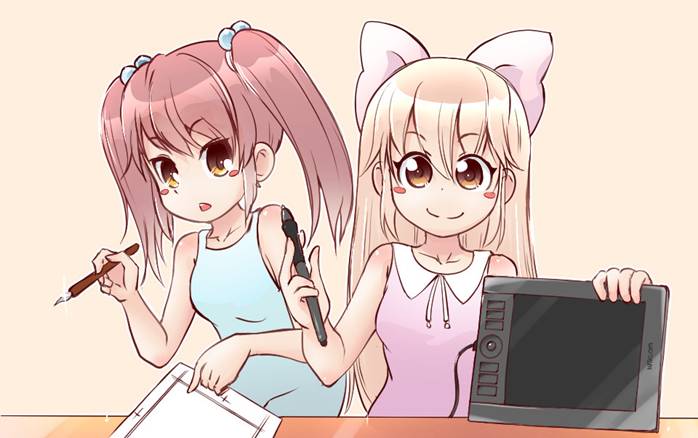
This article introduces the best tablets for beginners to digital art!
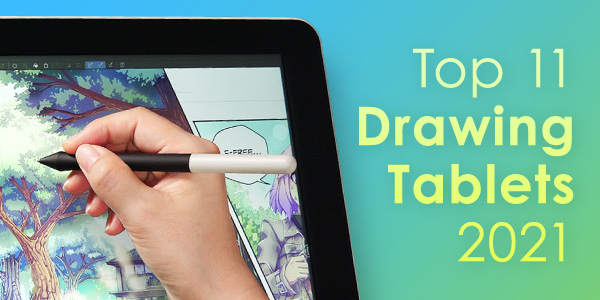
Method 1 for dealing with uncomfortable drawing tablets:
Match your hand movements with the movements on the screen
The first thing that you may want to fix is the ratio of the size of your drawing tablet to the size of your screen.
For example, if you use a small drawing tablet for a large monitor, moving the pen just a little bit will move the mouse significantly.
Conversely, if you use a large drawing tablet for a small monitor, you will need to move the pen a great distance to move the cursor on the screen.
One big reason for discomfort is this mismatch between the distance moved by the hand and the distance moved on the screen.
To fix this, you need to adjust your drawing environment.
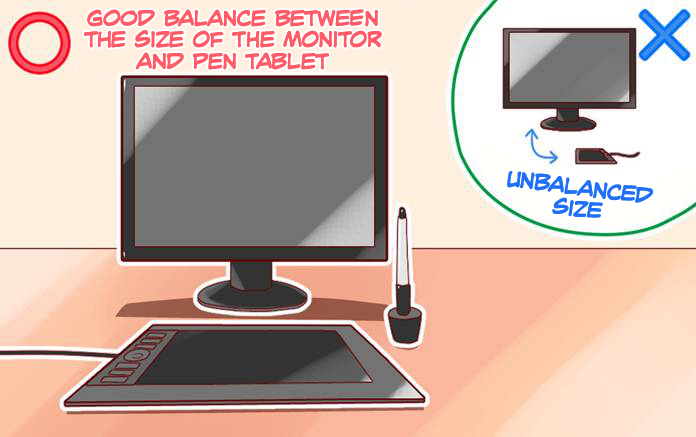
For artists that draw from the wrist
The average pen stroke distance when drawing using the wrist is around ten centimeters.
As a result, the drawing tablet also doesn't need to be too large. We place this small tablet in front of the monitor.
By pushing the monitor slightly back, the screen will look smaller, lessening the discomfort from the mismatch of hand and cursor.
For artists that draw from the elbow
Large strokes require you to use your entire arm to draw. Such lines could become 30cm in size, but buying a huge commercial-grade tablet isn't realistic. Instead, just find a large drawing tablet.
Pen strokes on a large tablet should match well with the cursor movement on a 15-inch monitor.
If your monitor is larger than 15 inches, try pushing it back a little to make it look smaller.
Wacom Intuos Series
Wacom Intuos Pro Series
Method 2 for dealing with uncomfortable drawing tablets:
Sit directly in front of the monitor and tablet
If you still feel discomfort after fixing the mismatch between your hands and cursor, the angle of the monitor and tablet may be the problem.
If you place the tablet at a slanted angle from the monitor, you will feel an "angle mismatch" between the movement of your hands and that of the cursor.
For example, let's say you want to draw one vertical line. If the drawing tablet is placed at a different angle from the monitor, a diagonal line will appear on the screen even though you drew a vertical line on the tablet. This is called an angle mismatch.
To fix this issue, keep these two things in mind when drawing.
・Place your drawing tablet directly in front of the monitor
・Face the monitor directly
By matching the direction of the monitor, drawing tablet, and yourself, you can fix this angle mismatch.
This, will let you draw the line that you want.
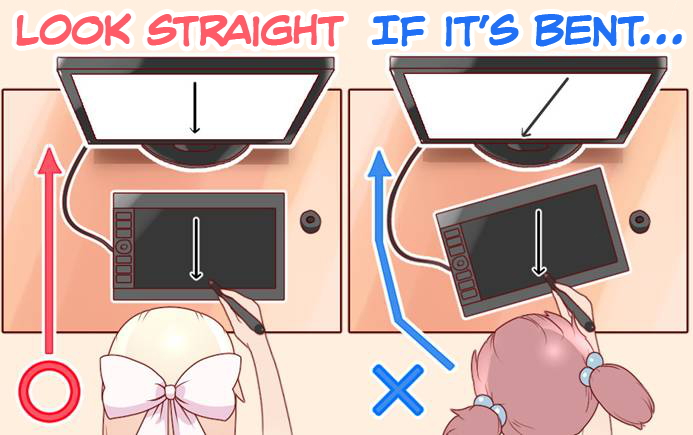
Angles are important!
As you get better, you will be able to correct these mismatches as you go. However, this might not be the case if you lose concentration from long hours of work. To decrease your burden, it's recommended to place your tablet directly facing the monitor whenever possible.
Method 3 for dealing with uncomfortable drawing tablets:
Check the friction between the drawing tablet and pen
One common concern is that the drawing tablet is "slippery" compared to pen and paper.
Since drawing tablets are made of slippery materials, there is less friction between them. If slipperiness is the main concern, then all we have to do is stop the slipping, right?
First of all, there are protective overlay sheets to increase friction. Buying one of these and using it will make it less slippery.
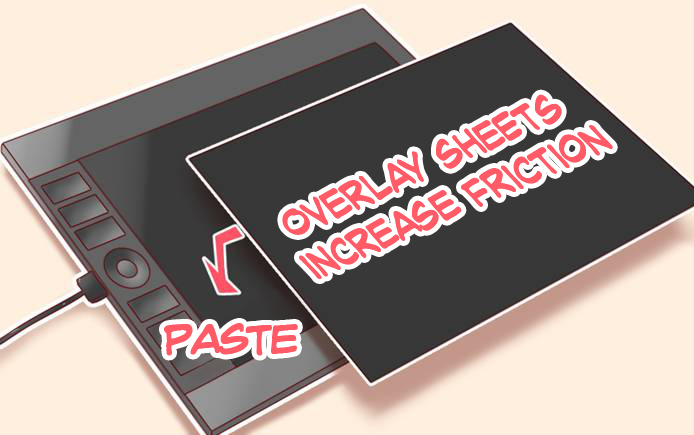
If you still feel that the pen is slippery, you can also replace the nib of the pen.
Some nibs can increase friction.
For example, Wacom Intuos Pro's"Felt pen nibs"have a rougher feel.
Using these nibs creates a paper-like drawing feel.
By customizing your tablet and pens with other products can produce friction and make you feel as if you were drawing on paper.
Note: The availability of protective sheets and nibs varies by manufacturer and model number of the tablet or pen. Always check your device's model number before purchase.
You could simply get used to the slippery tablet!
Although this article introduces ways to simulate a paper-like feel, having more friction causes more stress on the hands. The longer you draw, the more tired you will become. You might also get cramp or swelling in the hands. If you have to draw long hours, you don't want to spend too much energy drawing. Thus, it might help in the long run to get used to the smooth pen tablet.
Many people who have switched from traditional to digital drawing say that their hands have become less tired. Since there is less friction, it takes less effort to move the pen. That means inking also becomes much more efficient. It might be easier to have similar friction as pen and paper at first, but it would be better in the long run if you get used to low friction environments.
Check the thickness of the pen
We've introduced a lot of methods, but if none of them work for you, try checking the thickness of your pen.
For example, pens that come with the Wacom Intuos Pro are designed to be slightly thicker. This thickness might be just perfect for men, but it may be too thick for women.
Wacom Intuos Pro has a slightly thinner model called Wacom Pro Pen slim, so maybe you should try that out.
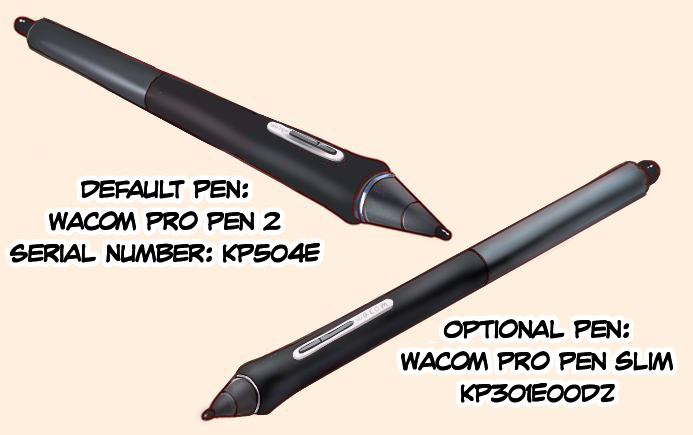
Method 4 for dealing with uncomfortable drawing tablets:
Settings – Adjusting pen pressure
There are three things to keep in mind when designing your drawing tablet to fit you: 1. The angle of the stroke, 2. the friction of the pen, and 3. the pen pressure level. If you've read this article from the beginning, you've probably already done steps one and two, so we're going to look at the final "pen pressure" adjustment to fix the discomfort.
There are two methods for setting up pen pressure, but many people only have one of the two set up.
・Via the drawing tablet's driver
・Via the drawing software
Driver adjustments let your drawing software easily process information from your drawing tablet. On the other hand, adjustments from the illustration software fine-tune the touch and feel for each tool.
Thus, it's recommended toadjust overall pen pressure from the tablet driver, thenadjust pen pressure for each tool from the drawing software.
1. Adjusting pen pressure from the tablet driver.
First, open the drawing tablet's driver. For Wacom tablets, search for "Wacom" to find "Wacom Tablet Property (Driver)" and click to open.
You might feel that the pen is so hard that you need to put a lot of pressure to start drawing. On the other hand, you might feel that the pen is so soft that simply touching it with the tablet will make it start drawing. These concerns can be solved on the tablet driver's "Tip feel" slider.
Note: Driver settings will vary by type of drawing tablet and their versions.

If you're feeling uncomfortable because your pen is too firm, move the "Tip feel" slider to the left to soften your pen.If you're feeling uncomfortable because your pen is too soft, move the "Tip feel" slider to the right to harden your pen.
There is a "Customize" button under "Tip feel." Clicking this will allow you to adjust advanced settings. However, since you will be changing these settings on the illustration software as well, you can leave this alone.
2. Adjusting pen pressure settings via the drawing software.
Once you're done with adjusting pen pressure in your driver, it's time to adjust pen pressure via the drawing software. We are going to use Clip Studio Paint as an example.
・Adjusting pen pressure levels for the entire software
After launching Clip Studio Paint, create a new canvas (the settings here aren't important), then select the File menu > Adjust pen pressure settings to adjust the pen pressure level of the entire software. Note. If you've already set 1., then you do not need to adjust this setting.
・Adjusting Pen pressure settings for each tool
With some drawing software such as Photoshop and Clip Studio Paint, you can set individual pen pressure curves for each tool.
In this example, we are going to use Clip Studio Paint to adjust pen pressure unique to the tool.
From Clip Studio Paint's Sub Tool, find your most frequently used pen to view its tool property.
By clicking on the small button at the right end of the brush size option, a dialog called "Brush Size Dynamics" will appear. This will allow you to set pen pressure.
If pen pressure isn't checked, check the box, then adjust the pen pressure graph below.
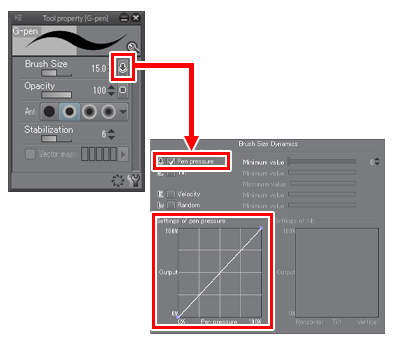
The horizontal axis is the pen pressure, and the vertical axis is the thickness of the brush.
The graph is a straight diagonal line by default, so let's adjust this to make it easier to draw. Here are two examples, so please use them as references!
Pen pressure settings for a softer feel
The pen will start to draw from the moment you place the pen on the tablet. The brush size will increase significantly, even if you only put a little pressure. The brush size will reach near maximum after 50% pen pressure, and it will barely increase after that.
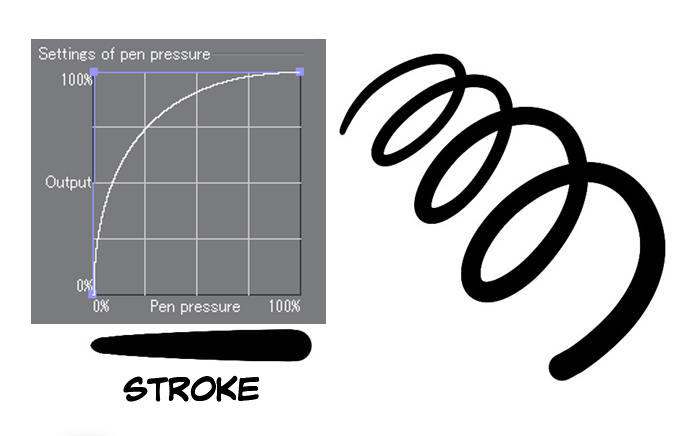
Pen pressure settings for a firm feel
The brush size will stay small while drawing, and will only increase after you put a good amount of pen pressure. By applying near-maximum pen pressure, the brush size will increase dramatically.
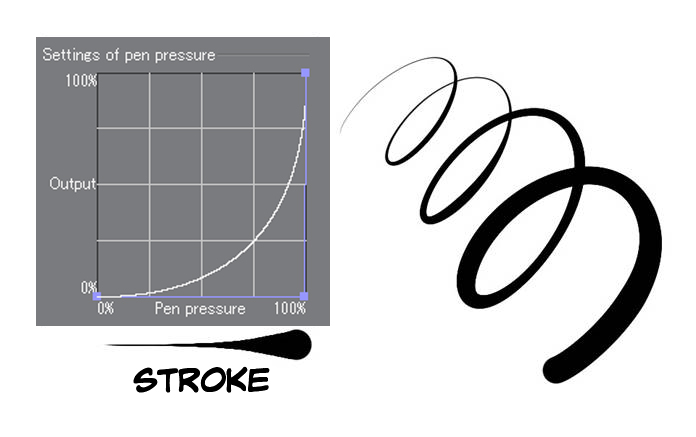
Learn to use your drawing tablet's useful features
There is more to drawing tablets than just drawing.
There are side switches on the side of the pen, function keys on the tablet itself, and on-screen controls that you can use by selecting specific buttons and function keys.
These buttons and function keys are usually used to set up shortcut keys.
Shortcut keys usually help reduce frustration and time, but they might feel a little advanced. Don't worry, you will get used to it as you use them!
1. Use the pen's side switches
Open Wacom's tablet properties. Click Input device > Pen to register shortcut keys to the two buttons on the side of the pen.
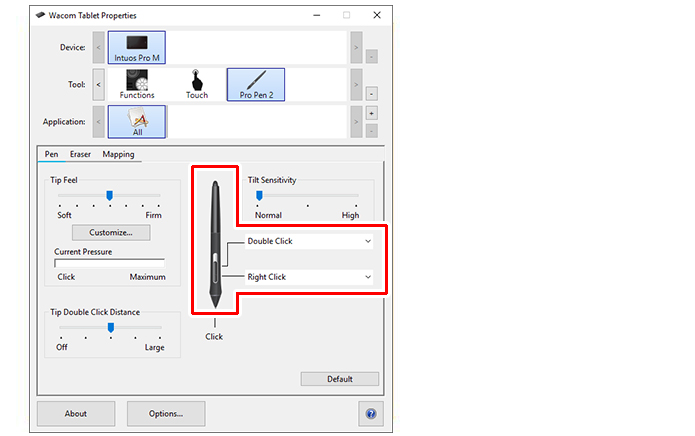
What should I register on the side switches?
Register your most frequently used shortcuts and functions to your side switches. Many people register commands like Undo, Redo, Eyedropper, Brush Size, and Eraser on their buttons. The eraser tool is also on the other end of the pen, but it's a lot easier to press a button than to flip the pen.
2. Use function keys!
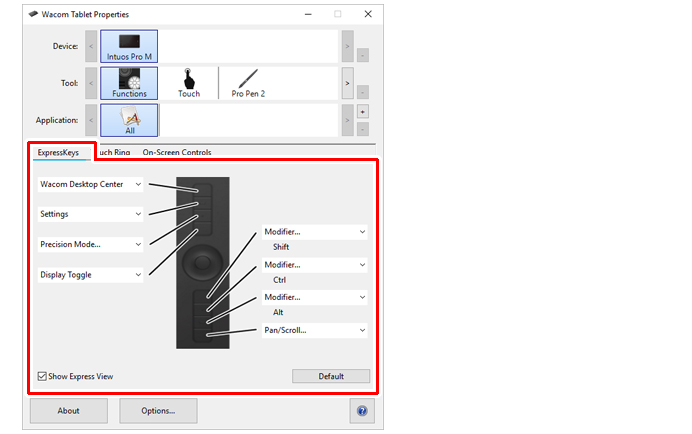
From the Wacom tablet properties, choose Input device > Function, then click on the Function key tab to set function keys.
It would help to register your frequently used tools and modifier keys to use the canvas.
Since you'll be using your other hand when using function keys, you can work efficiently by using both hands at the same time.
3. Use On-Screen Controls
In addition to hardware buttons, the Wacom pen tablet is also equipped with a digital function called "On-Screen Control" that allows you to use digital buttons temporarily displayed on the screen.
The On-Screen Control has many buttons, so you can register even more tools and operations. There are various customizable menus such as Radial Menus and Pull-down Menus in this feature. In this article, we will look at a simple Radial Menu.
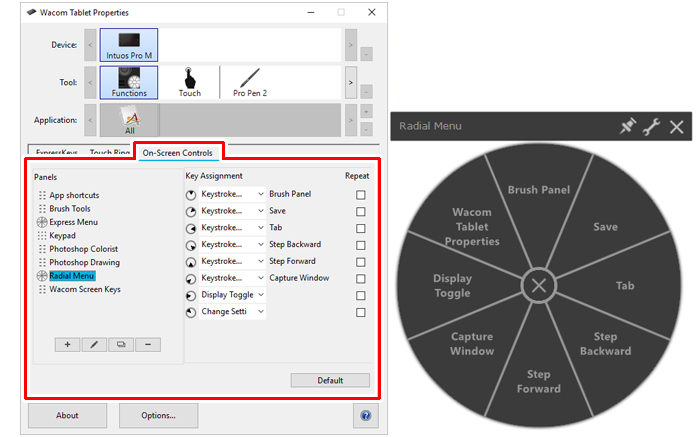
You can register up to 8 tools and operations at a time, and use further hierarchizing to register up to 8 × 8 = 64 tools and operations. By registering the operation to call up the Radial Menu to the pen's side switch or the tablet's function keys, you can efficiently utilize a lot of tools and operations with the pen tablet alone.
Modifier Key Settings Help!
In addition to shortcut settings, Clip Studio Paint has a Modifier Key Settings features. Modifier keys such as Shift, Ctrl, Alt, and the space bar can be used to change the tool (i.e., Holding down the Alt key to temporarily show the Eyedropper tool), but you can change this to something different (i.e., change the Alt key from Eyedropper to eraser).
Furthermore, you can set tools for multiple modifier keys (i.e., holding down Shift + Ctrl + Alt temporarily changes the tool to a bucket). This will let you register even more features. If you're using Clip Studio Paint, we advise you to customize these settings to fit your needs and use tablet side switches and function keys to your will.
Always keep spares of consumable tablet parts
Parts such as protective sheets and pen tips are consumables. They usually deteriorate over time. If protective sheets deteriorate, they lose friction. If the tip wears out, it will affect pen pressure and comfort.
These consumables may take time to restock depending on the region. It is generally advised to keep spares before they wear out.
・Where can I buy replacements?
Replacement parts for Wacom drawing tablets can be bought online at the Wacom Store or Amazon, or from retail stores that sell Wacom products.
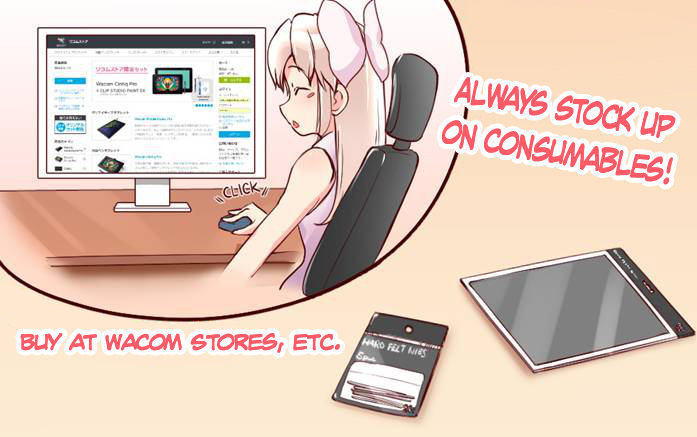
Summary
By adjusting the settings, your drawing tablet can become your best partner in art. There's a huge difference in drawing with a tablet that has all your favorite settings and drawing with a tablet that doesn't.
If you thought pen and paper was the only way to go, maybe try again with new and revised settings!
How to Draw a Straight Line Using Tablet
Source: https://www.clipstudio.net/how-to-draw/archives/155358
0 Response to "How to Draw a Straight Line Using Tablet"
Postar um comentário